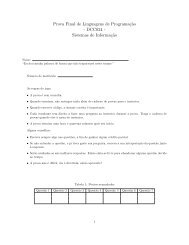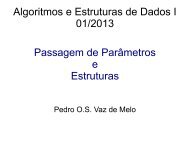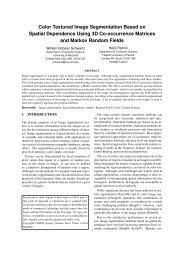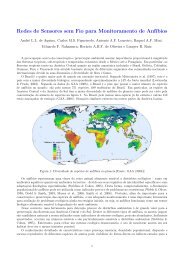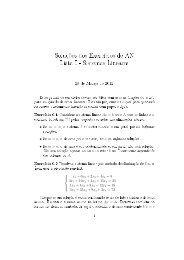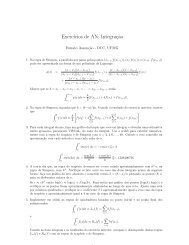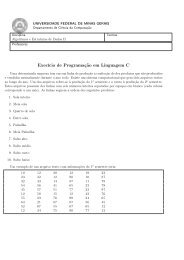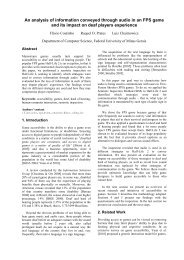Evolving Software Product Lines with Aspects: An Empirical ... - UFMG
Evolving Software Product Lines with Aspects: An Empirical ... - UFMG
Evolving Software Product Lines with Aspects: An Empirical ... - UFMG
You also want an ePaper? Increase the reach of your titles
YUMPU automatically turns print PDFs into web optimized ePapers that Google loves.
and alternative features (Section 4.3). Section 4.4 presents a<br />
discussion of the stability of the variability mechanisms.<br />
4.1 Including Mandatory Features<br />
This section reports and discusses the results of the change impact<br />
in releases 2 and 3 together because they share the common<br />
characteristic of adding mandatory features: EXCEPTIONHANDLING<br />
and LABELMEDIA, respectively. AO solution usually does not<br />
cope <strong>with</strong> the introduction of mandatory features in this study<br />
since it is not targeted at modularising them. For instance, all<br />
components added in the Java release 2 (new exceptions classes)<br />
are also included in the AO one. The main difference is that, the<br />
AO version added additional aspects to handle the exceptions<br />
included in this release, which also implies more operations<br />
(advices handling the exceptions [6, 13]) and LOC. The same<br />
phenomenon happens in release 3, where the class PhotoView<br />
Controller was included in both AO and non-AO versions.<br />
Besides, AspectJ solution also added to this release a new aspect<br />
related to the incorporation of the optional feature SORTING. It is<br />
important to notice that a perfective refactoring in release 3 which<br />
changes a reference from String to Image in the ImageData<br />
class implies more changes in operations and LOC of the AO<br />
version due to the number of pointcuts relying on that reference.<br />
4.2 Including Optional Features<br />
Regarding the introduction of optional features (releases 4 to 6),<br />
the AspectJ solution introduced more components because new<br />
aspects have to be included in addition to the classes realising the<br />
features. Note that in the AO implementation of the SPL, aspects<br />
usually work as glue between the core and optional features [1, 4].<br />
Operations are also included more in the AO solution due to the<br />
newly created advices. Despite the drawback of adding more<br />
elements, the AO solution often changes less components and<br />
operations. As a result, considering the Open-Closed principle<br />
[20], which states that ‘software should be open for extension, but<br />
closed for modification’, AO approach conforms more closely to<br />
this principle in scenarios which include optional features. For<br />
instance, the PersistenceManager component demanded<br />
changes in the Java release 4 in order to make favourite images<br />
persistent. On the other hand, the AO counterpart required no<br />
change in this component because the feature was implemented<br />
by new classes and the Favourites aspect.<br />
A direct result of more operations and components included in the<br />
AspectJ version is the increase in LOC. However, it is interesting<br />
to notice that sometimes AspectJ overcame this problem by<br />
avoiding some replicated code. For instance, despite the fact that<br />
the AO version has more added components in release 5 (6<br />
components in contrast to 5 in the Java version), the number of<br />
added LOC in the non-AO version is higher (19% more).<br />
4.3 Including Alternative Features<br />
The last two releases of MobileMedia introduced the alternative<br />
features MUSIC and VIDEO, respectively. However, release 7<br />
turned a mandatory feature into alternative leading to a big impact<br />
in the change propagation metrics. Such impact is a result of<br />
changes applied to the core assets of the SPL and, therefore,<br />
release 7 affected all optional features which rely on this core.<br />
When changing a mandatory feature into two alternatives (release<br />
7), AspectJ adds and changes more components/operations/LOC<br />
because all aspects rely on the points of intersection (join points)<br />
provided by the core. For instance, consider that a method in the<br />
core evolves to become optional in some concrete instances of the<br />
SPLs. In addition to changes in the class which contains this<br />
method, aspects that use this method as point of advising have to<br />
be changed as well.<br />
Unlike release 7, release 8 added a new alternative feature to an<br />
existing set of alternatives and the AO version required fewer<br />
changes of components/operations/LOC. Note that in this<br />
situation, changes are not targeted at a mandatory feature and,<br />
therefore, they do not change the points which aspects rely on.<br />
The measures of scenario 8 are similar to the introduction of an<br />
optional feature. That means, more components and operations<br />
added, but less of them are changed. Again, AspectJ adheres<br />
better to the Open-Closed principle [20].<br />
4.4 Stability of the Variability Mechanisms<br />
<strong>An</strong>other point to consider is the fragility of pointcut expressions<br />
and conditional compilation declarations. In terms of added<br />
constructs, in all scenarios (except Scenario 1) it is necessary to<br />
add more #ifdefs in the Java version than pointcuts into aspects<br />
(Table 3). This situation is due to the pointcut concept which<br />
allows a selection of a set of join points in the code while the<br />
conditional compilation mechanism spread over each place where<br />
intersections between core and other features exist. Therefore, a<br />
new #ifdef construct has to be added to capture each specific point<br />
of interception between the core and an optional/alternative<br />
feature. The only exception is release 2 because exception<br />
handling does not require conditional compilation in the non-AO<br />
version since it is mandatory.<br />
Depending on the evolution scenario, AspectJ pointcuts can be<br />
more fragile than conditional compilation. In release 7, for<br />
instance, it was necessary to refactor the name of a mandatory<br />
feature (PHOTO) in order to generalise it into two alternative<br />
features (PHOTO or MUSIC). In this case, every occurrence of this<br />
name had to be changed. Since certain aspects have several<br />
pointcuts relying on the syntactic match (e.g. names of methods<br />
and classes), this implies in many pointcuts being changed. On the<br />
other hand, #ifdefs do not need to be changed very often because<br />
they refer only to the feature name. In fact, conditional<br />
compilation tags had to be changed in releases 6 to 8 due to the<br />
sharing of code among more than one feature (see Figure 1).<br />
5. MODULARITY ANALYSIS<br />
This section presents the results for the second stage where we<br />
analyse the stability of the BestLap and MobileMedia product<br />
lines throughout the implemented changes. We used a metrics<br />
suite that quantified four fundamental modularity attributes,<br />
namely separation of concerns (Section 5.1), coupling, cohesion,<br />
and conciseness (Sections 5.2). Such metrics were chosen because<br />
they have already been used in several experimental studies and<br />
proved to be effective maintainability indicators (e.g. [7, 13-15]).<br />
The metrics for coupling, cohesion, and size were defined based<br />
on classic OO metrics [8]; the original metrics definitions were<br />
extended to be applied in a paradigm-independent way,<br />
supporting the generation of comparable results. In addition, this<br />
suite introduces four new metrics for quantifying separation of<br />
concerns (SoC) [11, 25]. They measure the degree to which a<br />
single concern (feature, in the case of this study) in the system



